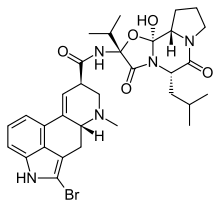Prolactin modulator
A prolactin modulator is a drug which modulates the secretion of the pituitary hormone prolactin from the anterior pituitary gland. Prolactin inhibitors suppress and prolactin releasers induce the secretion of prolactin, respectively.[1][2]
| Prolactin modulator | |
|---|---|
| Drug class | |
 Bromocriptine, a D2 receptor agonist, and the most commonly used prolactin inhibitor. | |
| Class identifiers | |
| Synonyms | Prolactin inhibitor; Prolactin releaser |
| Use | Hyperprolactinemia; Hypoprolactinemia |
| Biological target | D2 receptor (mainly) |
| In Wikidata | |
Prolactin inhibitors are mainly used to treat hyperprolactinemia.[1] Agonists of the dopamine D2 receptor such as bromocriptine and cabergoline are able to powerfully suppress pituitary prolactin secretion and thereby decrease circulating prolactin levels, and so are most commonly used as prolactin inhibitors.[1] Antiestrogens such as aromatase inhibitors and GnRH analogues are also able to inhibit the secretion of prolactin, though not nearly as robustly as D2 receptor agonists, and as such, they are not usually used as prolactin inhibitors.
Whereas D2 receptor agonists suppress prolactin secretion, dopamine D2 receptor antagonists like domperidone and metoclopramide have the opposite effect, powerfully inducing the pituitary secretion of prolactin, and are sometimes used as prolactin releasers, for instance to correct hypoprolactinemia in the treatment of lactation failure.[2] When such drugs are used not for the purpose of inducing prolactin secretion, increased prolactin levels may be unwanted, and can result in various side effects including mammoplasia (breast enlargement), mastodynia (breast pain/tenderness), galactorrhea (inappropriate or excessive milk production/secretion), gynecomastia (breast development in males), hypogonadism (low sex hormone levels), amenorrhea (cessation of menstrual cycles), reversible infertility, and sexual dysfunction.
D2 receptor agonists that are described as prolactin inhibitors include bromocriptine, cabergoline, lergotrile, lisuride, metergoline, quinagolide, and terguride.[3]
References
- Thomas L. Lemke; David A. Williams (24 January 2012). Foye's Principles of Medicinal Chemistry. Lippincott Williams & Wilkins. pp. 432–. ISBN 978-1-60913-345-0.
- University of Kansas School of Nursing Karen Wambach (15 August 2014). Breastfeeding and Human Lactation. Jones & Bartlett Publishers. pp. 182–. ISBN 978-1-4496-9729-7.
- George W.A Milne (8 May 2018). Drugs: Synonyms and Properties: Synonyms and Properties. Taylor & Francis. pp. 1579–. ISBN 978-1-351-78989-9.